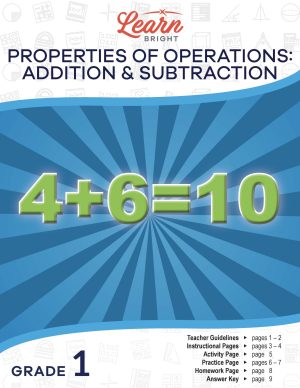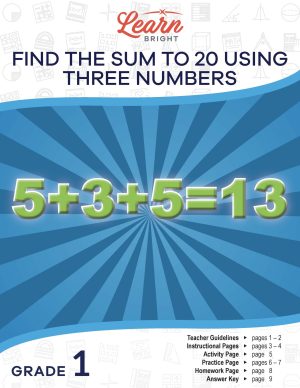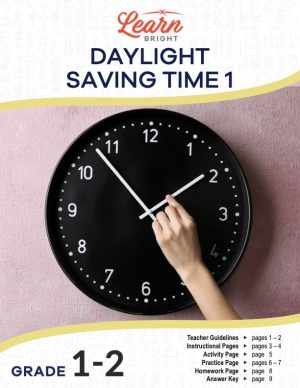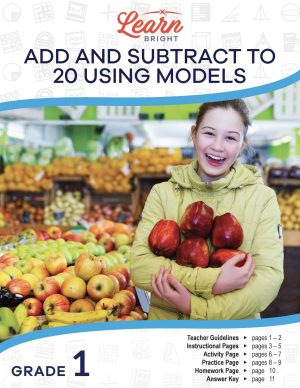Description
What our Missing Addends and Subtrahends lesson plan includes
Lesson Objectives and Overview: Missing Addends and Subtrahends introduces students to finding missing addends and subtrahends. It provides clear explanations and examples of two strategies students can use to solve problems. At the end of this lesson, students will be able to understand and apply fact families to finding missing addends and subtrahends. They will also be able to solve for missing addends and subtrahends in word problems. This lesson is for students in 1st grade.
Classroom Procedure
Every lesson plan provides you with a classroom procedure page that outlines a step-by-step guide to follow. You do not have to follow the guide exactly. The guide helps you organize the lesson and details when to hand out worksheets. It also lists information in the blue box that you might find useful. You will find the lesson objectives, state standards, and number of class sessions the lesson should take to complete in this area. In addition, it describes the supplies you will need as well as what and how you need to prepare beforehand. The supplies you will need for this lesson include decks of cards, pencils, pens, and highlighters.
Options for Lesson
Included with this lesson is an “Options for Lesson” section that lists a number of suggestions for activities to add to the lesson or substitutions for the ones already in the lesson. All of the suggestions for the lesson relate to the lesson activity. During the activity, you can add in a third person for a more challenging approach so that students have to add a second step in solving the problem. You could also have your students write down the problem and their answers on a score sheet during the game to be graded. Finally, you could consider making different card decks to differentiate the learning.
Teacher Notes
The teacher notes page includes a paragraph with additional guidelines and things to think about as you begin to plan your lesson. This page also includes lines that you can use to add your own notes as you’re preparing for this lesson.
MISSING ADDENDS AND SUBTRAHENDS LESSON PLAN CONTENT PAGES
Missing Addends and Subtrahends
The Missing Addends lesson plan includes two content pages. Missing addends are numbers missing from addition problems and missing subtrahends are numbers missing from subtraction problems. You can solve for an unknown value in an equation on either side of the equal sign and in either position for the addend or subtrahend.
We represent missing values using placeholders, which signify an unknown amount. The placeholder can be any symbol such as a variable (x), empty space ( ), question mark (?), or random shape (). By using symbols, you reinforce the missing value.
Missing Addend Examples
For the problem 9 + ? = 12, we ask ourselves what number added to nine will equal twelve? We can solve this problem using subtraction: 12 – 9 = 3. We can also solve this problem by counting up from 9 to 12. Either way, the solution is 3.
For the problem ? + 7 = 13, we ask ourselves what number added to seven will equal thirteen? We can solve this problem using subtraction: 13 – 7 = 6. We can also solve this problem by counting up from 7 to 13. Either way, the solution is 6.
Missing Subtrahend Examples
For the problem 15 – ? = 11, we ask ourselves what number subtracted from fifteen will equal eleven? We can solve this problem using addition: 11 + ? = 15. We can also solve this problem by counting down from 15 to 11. Either way, the solution is 4.
For the problem 10 – ? = 3, we ask ourselves what number subtracted from ten will equal three? We can solve this problem using addition: 3 + ? = 10. We can also solve this problem by counting down from 10 to 3. Either way, the solution is 7.
Fact Families
Knowing fact families is very helpful for finding missing addends and subtrahends. For example, if you know that 3 + 4 = 7, you can use that knowledge to find the missing value in the following equation: 7 – ? = 3.
Creating fact families assists with understanding how to switch addition problems to subtraction problems and vice versa.
Word Problems
We use word problems to solve the real-world applications of missing addends and subtrahends. The lesson includes an example word problem.
In the example, someone is planning a birthday party for their dog. For the party, ten dogs will come to their house. They want to buy party favors for each dog, but they want to buy different favors for the girl dogs and boy dogs. They know that six of the dogs are girls, but they don’t know how many are boys.
To solve this problem, we first need to create an equation: 6 + ? = 10. We ask ourselves what number plus 6 will equal 10? We can then solve this problem using subtraction: 10 – 6 = 4. We can also solve this problem by counting up from 6 to 10. Either way, we discover that the solution is 4. Therefore, there will be four boy dogs at the party.
The lesson also shows how you can use pictures to solve problems with missing addends. For this problem, you could draw 10 dogs and circle the six girl dogs in red. You could then circle the rest of the dogs in blue. These are the boys. Count the dogs with blue circles. There are four boy dogs!
MISSING ADDENDS AND SUBTRAHENDS LESSON PLAN WORKSHEETS
The Missing Addends and Subtrahends lesson plan includes three worksheets: an activity worksheet, a practice worksheet, and a homework assignment. You can refer to the guide on the classroom procedure page to determine when to hand out each worksheet.
SALUTE CARD GAME ACTIVITY WORKSHEET
Students will work in groups of three to complete the lesson activity. Each group will rotate the role of the dealer. For each round, the dealer will hand both of the other students in their group a card face down. When they say “Salute!”, the players will place their card facing out on their forehead. The dealer will then add the two cards together and say the sum out loud. The players will then figure out what number is on their card (the missing addend) using the sum and the other player’s card. They will then rotate who the dealer is and play again.
SOLVING PROBLEMS PRACTICE WORKSHEET
For the practice worksheet, students will solve eight problem, showing how they solved them. They will also solve a word problem.
MISSING ADDENDS AND SUBTRAHENDS HOMEWORK ASSIGNMENT
The homework assignment asks students to first solve a word problem. They will then create their own word problem, including a picture. They will show the solution using both an addition and subtraction problem.
Worksheet Answer Keys
This lesson plan includes answer keys for the practice worksheet and the homework assignment. If you choose to administer the lesson pages to your students via PDF, you will need to save a new file that omits these pages. Otherwise, you can simply print out the applicable pages and keep these as reference for yourself when grading assignments.









